
Electric Storm wind turbine, The South Bank 🌍
Update: March 2004: Electric Storm is finished.
A 45 meter tall wind turbine has been built in central London, as part of
a temporary installation along London's South Bank, called the
Shell Electric Storm.
The turbine is designed to generate sufficient power such that there is a net
zero enegy consumption by the whole installation, which runs for 4 months
as a free attraction each night from dusk to 11pm. This comprises
lighting reminiscent of "the Northern Lights", with the addition of mist
and sound effects, and rather than being pre-programmed, the effects are
driven by various environmental readings continuously made at the site.
The project is also backed by the DTI, as part of a campaign to encourage
renewable energy.
Images
Artist's Impression
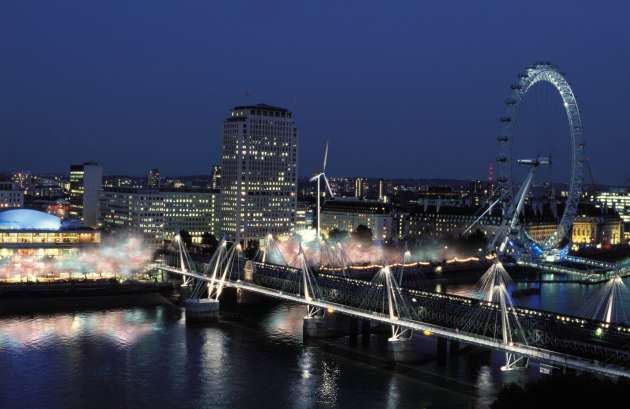
Artist's impression of the whole installation
The Wind Turbine
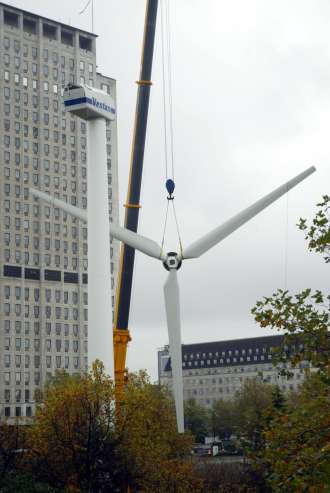
Lifting the turbine blades - 12th Nov 2003
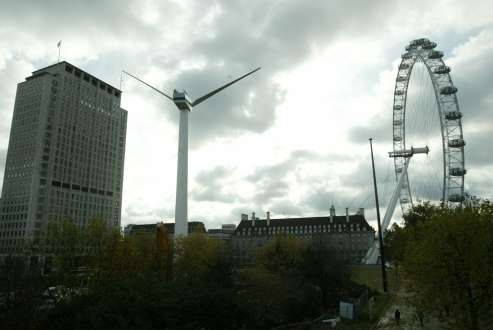
Turbine and the London Eye - 12th Nov 2003
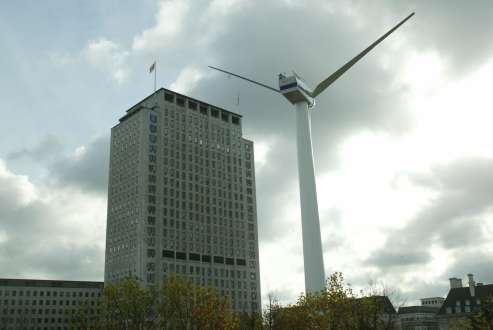
Turbine and the Shell Building - 12th Nov 2003
Location
The installation runs along the South Bank of the Thames, between the
London Eye, past Hungerford Bridge, and Waterloo Bridge and beyond. The
wind turbine itself is installed in the South Bank coach park by Hungerford
Bridge.
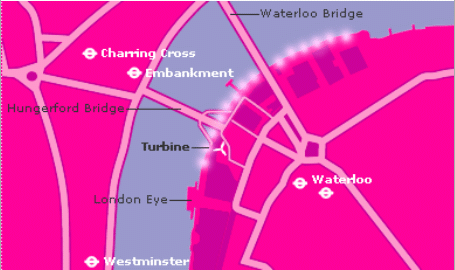
The wind turbine
The wind turbine is a 225kW V27 model, made by Danish turbine manufacturer
Vestas. It has a hub height of 31 metres, a 3-bladed rotor diameter of 27
metres and a total height to blade tip of 45 metres.
The foundation design involves
piles of 27 metres depth in an area with complicated ground conditions in
the centre of a busy major city.
Installation Details
These details were provided by the projects press office - I've yet to verify
them independently.
Concept
At the heart of Shell Electric Storm are sustainability and renewable
energy. These are the themes that Shell Electric Storm aims to
communicate and have also influenced the design of the project. Shell
Electric Storm stretches from Jubilee Gardens, next to the London Eye,
along the South Bank in front of the Royal Festival Hall and National
Theatre, up to the IBM Building. Installations in 38 trees uses a
combination of light, mist and sound, directly influenced by the
prevailing weather conditions to create an effect reminiscent of the
Northern Lights.
Power Supply
A 43 metre high, 225 KW wind turbine, located in the South Bank Coach Car
park near Hungerford Bridge, generates the energy needed to power the
show. This energy does not feed directly into the tree installations, but
is routed into the Royal Festival Hall where it is fed into the
National Grid and the energy needed to power the light, mist and sound
show is drawn from there. This replicates the process that takes
place on a wind farm - the energy generated by the turbines is fed
directly into National Grid, from where it is taken to meet energy
requirements across the UK.
Trees
The mature trees along the South Bank are used to house separate
light, mist and sound units. There are single units in each tree and
the system is designed so that if one unit fails, it has minimal
effect on the overall installation.
Power, water and data reaches these units via trunking and piping
placed underground along the Jubilee walkway. The power/water cables
rise up from the ground into a box by the river wall where it rises up
into the trees and is distributed amongst the tree at high level.
Lighting
Three distinct types of lighting effect form the central core of the
installation, achieved through an innovative and energy efficient design.
These are called 'ambient', 'gesture' and 'hotspot'. For the purposes of
the lighting units, the trees are divided into 10 groups. Each tree
within the group has 10 different controls enabling sequential
switching and giving the whole installation the possibility of creating a
multitude of differing effects.
The lighting instruments, which are designed to be recyclable, low-energy,
high-output lamps, are constructed and fitted within two collars at a
high and a low level in each tree.
Mist
High-pressure misters, similar to those used in greenhouses and for
agricultural purposes, produce a wind-borne micro-mist of water
through a number of nozzles in each tree. The small size of these
particles reduces precipitation to a minimum. To stop frozen water
splitting the pipes and to ensure on-lookers do not slip on icy surfaces,
the mist is inoperable when the temperature falls below zero. The
mist units are controlled by three master pumps spread along the Jubilee
walkway. The mist is operated by DMX controls which tell the mist when to
turn on and off.
Sound
Shell Electric Storm uses an innovative sound system called Timax. There
are a number of speakers positioned at different points along the
South Bank. In some instances these are on trees and others attached
to the nearby buildings. The speakers are strategically positioned to
allow the sound to move around you as you are in Shell Electric Storm.
The sound is at 50db which is a little louder than ambient city
noise. The Timax system, as with all the elements of the show, is
controlled by the prevailing weather conditions. Anemometers and mini
weather stations at various points along the South Bank collate
meteorological data which then programme all the show elements to make an
ever-changing 'real time' experience.
Street Furniture
Text relating to the issues around Shell Electric Storm - renewable energy
and sustainable resources - are incorporated into the existing
benches, along the South Bank throughout the duration of the show. These
provide additional information and interest for visitors and direct
people to the Shell Electric Storm website where they can find more
information on renewable energy.
Timeline
| 19th May 2003 |
(revised) Planning Application submitted to Lambeth Council |
| 25th June 2003 |
Lambeth Council consults London Mayor's office on the planning application |
| 16th July 2003 |
Mayor's office considers report on the project, and asks for more details |
| 13th August 2003 |
Lambeth Council ready to grant planning permission for project |
| 27th August 2003 |
Mayor's office ratifies planning decision |
| 16th October 2003 |
Start of excavation for wind turbine foundations |
| 12th November 2003 |
Wind turbine blades lifted into place |
| 18th November 2003 |
Switch On, by Patricia Hewitt, Secretary of State for Trade and Industry |
| 1st December 2003 |
1st Day of Advent - special display |
| 25th December 2003 |
Christmas Day - special display |
| 31st December 2003 |
New Year's Eve - special display |
| 14th February 2004 |
St Valentine's Day - special display |
| Mid February 2004 |
Installation comes to an end |
| 16th March 2004 |
Expiry of planning permission |
Links
Other News reports
| Last updated
16/09/2025 |
Text and images © Mark Berry,
1997-2025 -
|






